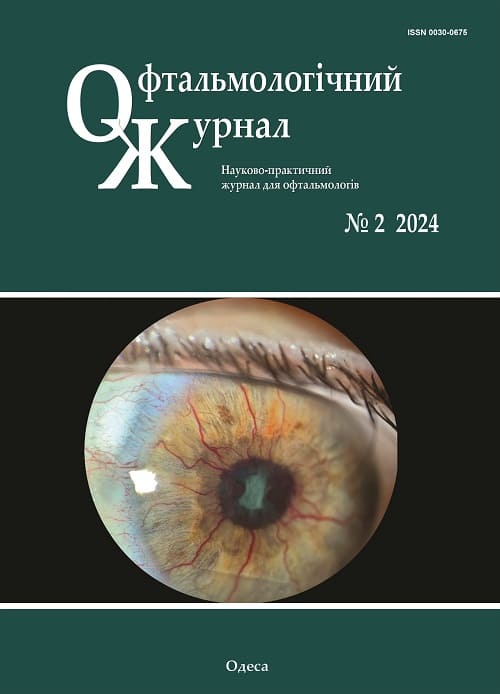Pediatric dog-bite injuries of the ocular adnexa
DOI:
https://doi.org/10.31288/oftalmolzh202424951Keywords:
bite injury, ocular adnexa, childrenAbstract
Background: Although domestic dogs have been human companions for thousands of years, their uncontrolled aggressive behavior may cause a canine attack on a human, leading to severe injuries. As much as 1.5% of the population receives a dog bite requiring medical attention annually and dog bite prevalence is twice as high among children when compared to the population of other age groups.
Purpose: To review the clinical features of and outcomes of surgical treatment for pediatric dog-bite injuries to the ocular adnexa.
Material and Methods: We retrospectively reviewed the clinical features of and outcomes of surgical treatment for pediatric dog-bite injuries to the ocular adnexa in 25 children aged 2-13 years (mean age, 5.5 ± 3.1 years).
Results: Bites affecting the lower eyelid were most common (68%). An injury to the lacrimal duct in the form of canalicular avulsion was seen in 52% of all cases and 76.9% of children with a lower eyelid injury. All children received urgent primary surgical wound repair (PSWR) with suture wound closure. When a laceration of the inferior canaliculus occurred, canaluculus repair and intubation was performed using different methods.
Conclusion: During PSWR, necrosed tissue should be removed with preservation of vital tissue as much as possible, because adequate vascularization and young age contribute to active tissue reparation. Restoration of the integrity of and passage through the lacrimal duct are essential to prevent postoperative epiphora.
References
Ozanne-Smith J, Ashby K, Stathakis VZ. Dog bite and injury prevention: analysis, critical review, and research agenda. Inj Prev. 2001;7(4):321-6. https://doi.org/10.1136/ip.7.4.321
Gilchrist J, Sacks JJ, White D, et al. Dog bites: still a problem? Inj Prev. 2008;14(5):296-301. https://doi.org/10.1136/ip.2007.016220
Lee ChJ., Tiourin E, Schuljak S, Phan J, et al Surgical Treatment of Pediatric Dog-bite Wounds: A 5-year Retrospective Review. West J Emerg Med. 2021 Nov; 22(6): 1301-1310. https://doi.org/10.5811/westjem.2021.9.52235
Meints K, Brelsford V, De Keuster T. Teaching Children and Parents to Understand Dog Signaling Front. Vet Sci. 2018; 5: 257. https://doi.org/10.3389/fvets.2018.00257
Chen HH, Neumeier AT, Davies BW, et al. Analysis of pediatric facial dog bites. Craniomaxillofac Trauma Reconstr. 2013;6(4):225-31. https://doi.org/10.1055/s-0033-1349211
Cook JA, Sasor SE, Soleimani T, et al. An epidemiological analysis of pediatric dog bite injuries over a decade. J Surg Res. 2020;246:231-5. https://doi.org/10.1016/j.jss.2019.09.013
McLoughlin RJ, et al. Hospitalizations for pediatric dog bite injuries in the United States. J Pediatr Surg. 2020;55(7):1228-33. https://doi.org/10.1016/j.jpedsurg.2019.06.025
HSCIC (Health and Social Care Information Centre) Accident and Emergency Attendances in England - 2014-15. (2015). Available online at: https://digital.nhs.uk/data-and-information/publications/statistical/hospital-episode-statistics-for-admitted-patient-care-outpatient-and-accident-and-emergency-data/provisional-monthly-hospital-episode-statistics-for-admitted-patient-care-outpatients-and-accident-and-emergency-data-april-2014-to-february-2015
O'Brien DC, Andre TB, Robinson AD, Squires LD. Dog bites of the head and neck: an evaluation of a common pediatric trauma and associated treatment. Am J Otolaryngol. 2015 Jan-Feb; 36(1): 32-38. https://doi.org/10.1016/j.amjoto.2014.09.001
Wu PS, Beres A, Tashjian DB, Moriarty KP. Primary repair of facial dog bite injuries in children. Pediatric emergency care. 2011;27(9):801-3. https://doi.org/10.1097/PEC.0b013e31822c1112
Eppley BL, Schleich AR. Facial dog bite injuries in children: treatment and outcome assessment. The Journal of craniofacial surgery. 2013;24(2):384-6. https://doi.org/10.1097/SCS.0b013e31827fee33
Rui-feng C, Li-song H, Ji-bo Z, Li-qiu W. Emergency treatment on facial laceration of dog bite wounds with immediate primary closure: a prospective randomized trial study. BMC emergency medicine. 2013;13 (Suppl 1): S2. https://doi.org/10.1186/1471-227X-13-S1-S2
Touré G, Angoulangouli G, Méningaud JP. Epidemiology and classification of dog bite injuries to the face: a prospective study of 108 patients. J Plast Reconstr Aesthet Surg. 2015;68:654-658. https://doi.org/10.1016/j.bjps.2015.01.001
Mannion CJ, Graham A, Shepherd K, Greenberg D. Dog bites and maxillofacial surgery: what can we do? Br J Oral Maxillofac Surg. 2015;53:522‐525. https://doi.org/10.1016/j.bjoms.2015.02.022
Macedo JL, Rosa SC, Queiroz MN, Gomes TG. Reconstruction of face and scalp after dog bites in children. Rev Col Bras Cir. 2016;43:452‐457. https://doi.org/10.1590/0100-69912016006007
Kumar R, Deleyiannis FW, et al. Neurosurgical sequelae of domestic dog attacks in children. J Neurosurg Pediatr. 2017;19:24‐31. https://doi.org/10.3171/2016.7.PEDS1646
Chen T, Karim М, Grace ZT, Magdich AR, Carniol Eric C, et al. Surgical management of facial dog bite trauma: A contemporary perspective and review. World J Otorhinolaryngol Head Neck Surg. 2023 Jun; 9(2): 123-130. https://doi.org/10.1002/wjo2.75
Ambro BT, Wright RJ, Heffelfinger RN. Management of bite wounds in the head and neck. Facial Plast Surg. 2010;26(6):456-63. https://doi.org/10.1055/s-0030-1267720
Foster MD, Hudson JW. Contemporary update on the treatment of dog bite: injuries to the oral and maxillofacial region. J Oral Maxillofac Surg. 2015;73:935‐942. https://doi.org/10.1016/j.joms.2014.12.003
Downloads
Published
How to Cite
Issue
Section
License
Copyright (c) 2024 Світлана Троніна

This work is licensed under a Creative Commons Attribution 4.0 International License.
This work is licensed under a Creative Commons Attribution 4.0 International (CC BY 4.0) that allows users to read, download, copy, distribute, print, search, or link to the full texts of the articles, or use them for any other lawful purpose, without asking prior permission from the publisher or the author as long as they cite the source.
COPYRIGHT NOTICE
Authors who publish in this journal agree to the following terms:
- Authors hold copyright immediately after publication of their works and retain publishing rights without any restrictions.
- The copyright commencement date complies the publication date of the issue, where the article is included in.
DEPOSIT POLICY
- Authors are permitted and encouraged to post their work online (e.g., in institutional repositories or on their website) during the editorial process, as it can lead to productive exchanges, as well as earlier and greater citation of published work.
- Authors are able to enter into separate, additional contractual arrangements for the non-exclusive distribution of the journal's published version of the work with an acknowledgement of its initial publication in this journal.
- Post-print (post-refereeing manuscript version) and publisher's PDF-version self-archiving is allowed.
- Archiving the pre-print (pre-refereeing manuscript version) not allowed.












